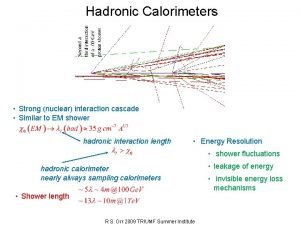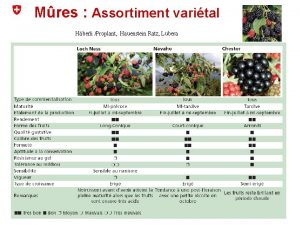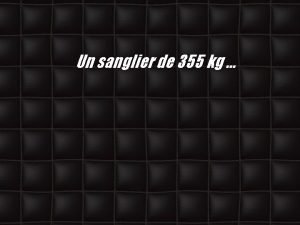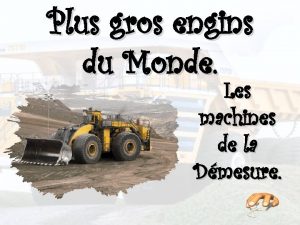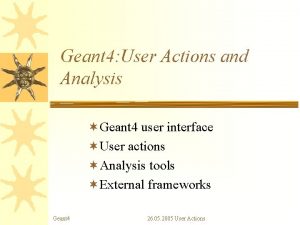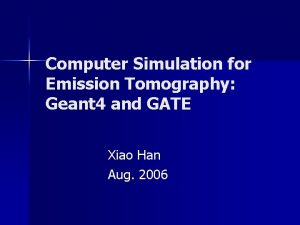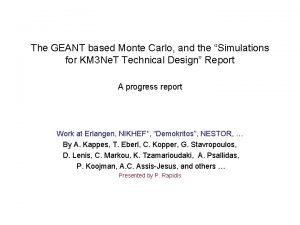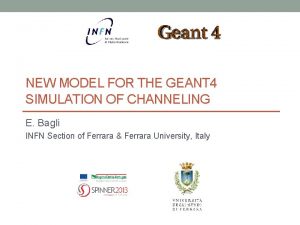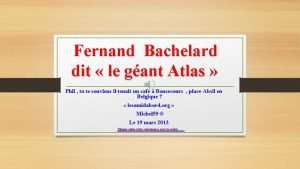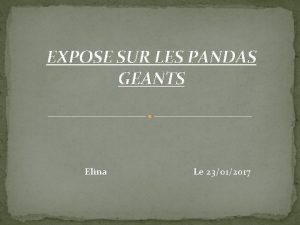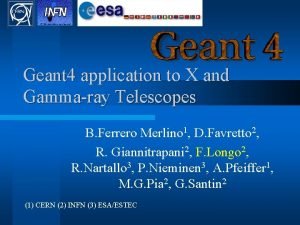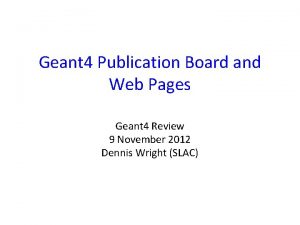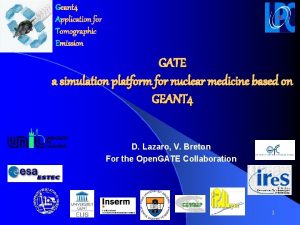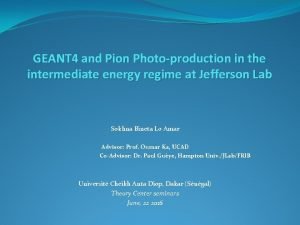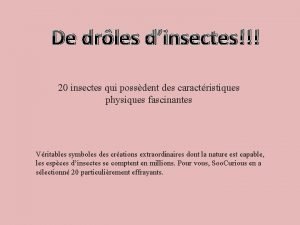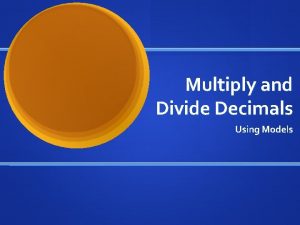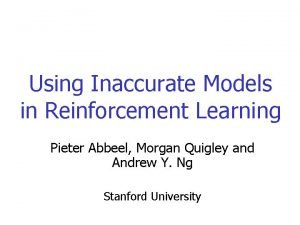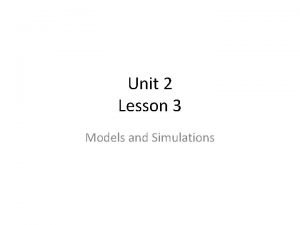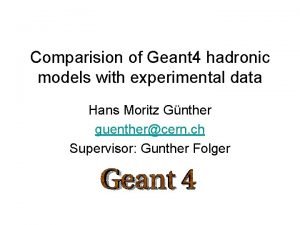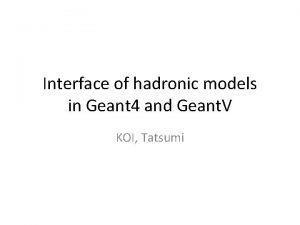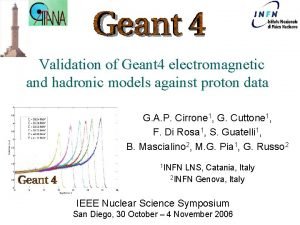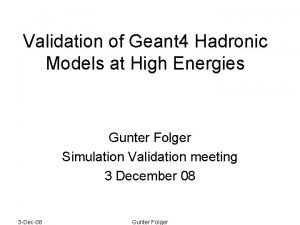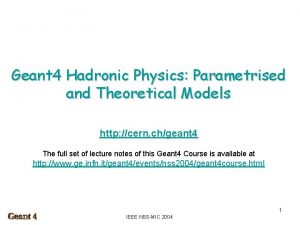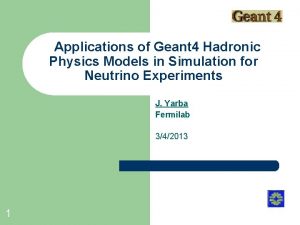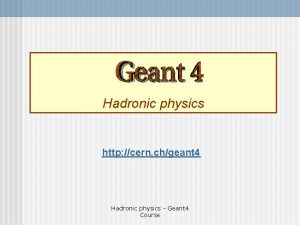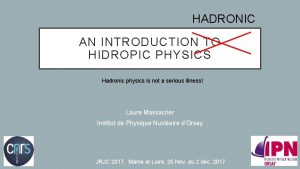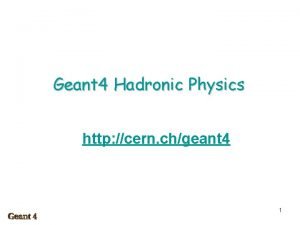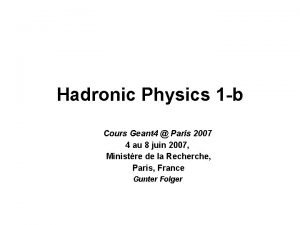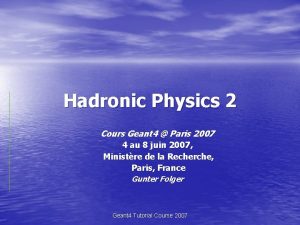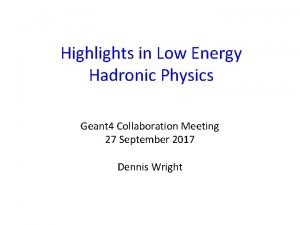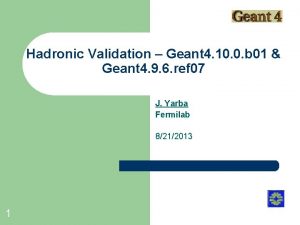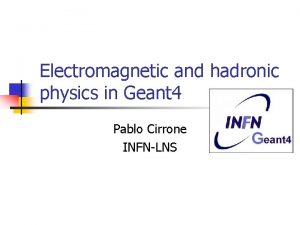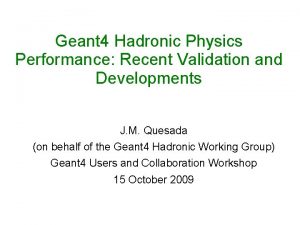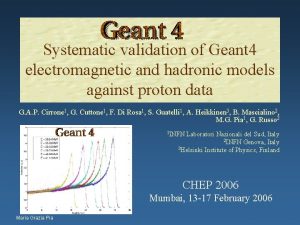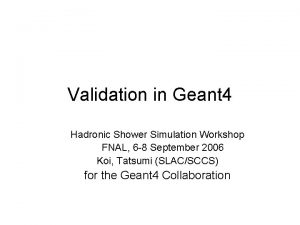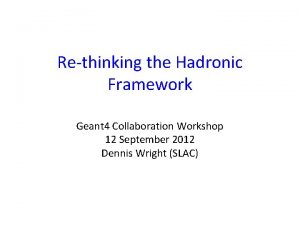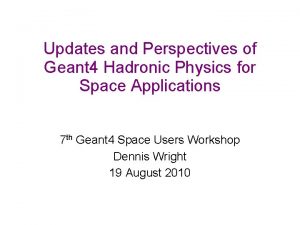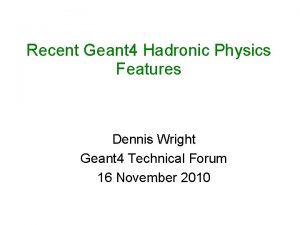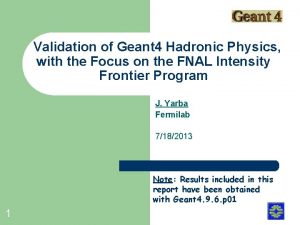Test of Hadronic Models in GEANT 4 using




























- Slides: 28

Test of Hadronic Models in GEANT 4 using the BESIII Data G. F. Cao, H. M. Liu 14 th Geant 4 Users and Collaboration Workshop, Catania, Italy, 15 -22 October, 2009

Outline • • The Experiment – Collider and Detector BESIII Commissioning and Data Taking MC Simulation Validation of Hadronic Models in GEANT 4 Ø Data Sample Ø EM Validation Ø Hadronic Models Validation • Summary 14 th Geant 4 Users and Collaboration Workshop 2

BEPCII Project (Beijing Electron Positron Collider) • Beam energy: 1~2. 3 Ge. V • Designed peak luminosity: 1033 cm-2 s-1 at Ecm=3. 77 Ge. V • Energy spread: 5. 16 × 10 -4 • Cross angle: 22 mrad • No. of bunches: 93 • Bunch length: 1. 5 cm • Physics: tau-charm physics, charmonium physics, light hadron, QED, new physics 14 th Geant 4 Users and Collaboration Workshop 3

The BESIII Experiment (BES - BEijing Spectrometer) Main Drift Chamber (MDC): xy = 130 m P/P = 0. 5 %@1 Ge. V d. E/dx = 6 -7 % Super-conducting Magnet: 1. 0 Tesla TOF System: T = 90 ps barrel 110 ps endcap Muon Chamber (MUC): RPC based EM Calorimeter (EMC): E/E = 2. 5 % @ 1 Ge. V z, = 0. 6 cm @ 1 Ge. V 14 th Geant 4 Users and Collaboration Workshop 4

BESIII Commissioning and data taking milestones Mar. 2008: First full cosmic-ray event April 30, 2008: Move the BESIII to IP July 19, 2008: First e+e- collision event in BESIII Peak Lumi. @ Nov. 2008: 1. 2× 1032 cm-2 s-1 Peak Lumi. @ May 2009: 3. 2× 1032 cm-2 s-1 ´ 5 CESRc ´ 30 BEPC Nov. 2008: ~ 14 M ψ(2 S) events collected April 14, 2009: ~110 M ψ(2 S) events collected(4×CLEOc) May 30, 2009: 42 pb-1 at continuum collected (Ecm = 3. 65 Ge. V) July 28, 2009: ~200 M J/ψ events collected(4×BESII) 14 th Geant 4 Users and Collaboration Workshop 5

BESIII MC Software BOOST Project BESIII Object Oriented Simulation Tool (proposal: August, 2002) BES MC Software Evolution BESIII SOBER SIMBES BOOST EGS G 3 G 4 1980 s 1990 s 2000 s 14 th Geant 4 Users and Collaboration Workshop 6

BOOST Architecture Event KKMC+Be s. Evt. Generator Geometry Geant 4 Tracking Hep. Evt format Detector Digitization Response Hit objects 14 th Geant 4 Users and Collaboration Workshop Raw data MC truth 7

BESIII MC – main components • • • Detector Description (based on GDML) Event Generator Physics processes Magnetic field Digitization MC truth Data I/O Trigger simulation Background mixing 14 th Geant 4 Users and Collaboration Workshop 8

BOOST Working in BOSS – BESIII Offline Software System BOOST based on GEANT 4 BOSS based on GAUDI Generator Simulation Calibration Reconstructin MC data Analysis 14 th Geant 4 Users and Collaboration Workshop 9

Current status of MC software • The geometry, material and magnetic field have been well described. • Digitization, trigger simulation and background mixing have been seriously considered and tuned by experimental data. • Billions of MC samples have been generated and used for MC tuning and physics analysis. • The comparisons between MC and data are generally satisfactory. 14 th Geant 4 Users and Collaboration Workshop 10

Validation of Hadronic Models in GEANT 4 14 th Geant 4 Users and Collaboration Workshop 11

Hadronic Models in GEANT 4. 9. 0. p 01 Physics lists QBBC QGSP_BERT_HP QGSP_BERT QGSP_BIC QGSP π+/π- Proton Anti-proton BERT (0 -4 Ge. V) BERT (0 -9. 9 Ge. V) LE_GHEISHA (0 -25 Ge. V) BIC (0 -4 Ge. V) BERT (0 -9. 9 Ge. V) BIC (0 -9. 9 Ge. V) LE_GHEISHA (0 -25 Ge. V) CHIPS (0 -4 Ge. V) LE_GHEISHA (0 -25 Ge. V) The same EM and decay process 14 th Geant 4 Users and Collaboration Workshop 12

Data Sample Selection ~10 M ψ(2 S) data taken in 2008 • Need to be considered in data sample selection: Ø Data sample purity is of the top priority. Ø More stringent selection criteria should be applied, even lose some efficiency. Ø Least EMC information should be used in event selection. • So, we select π+/π-, e+/e- from Background level ~ 0. 1% • And we select proton and anti-proton from Background level ~ 0. 7% 14 th Geant 4 Users and Collaboration Workshop 13

p and cosθ distributions of π+/π-, p/ samples Monte Carlo samples are normalized to the number of events in data. Dots:Data Histo. : MC (QGSP_BERT) 14 th Geant 4 Users and Collaboration Workshop 14

Compared variables Behavior of hadrons in EM calorimeter, Cs. I(TI) crystals • Basic variables Ø E 5× 5: Energy deposited in 5× 5 crystals around the seed in a shower. Ø Eseed/E 3× 3: The ratio of the energy deposited in the seed and the energy deposited in 3× 3 crystals. Ø E 3× 3/E 5× 5: The ratio of the energy deposited in 3× 3 crystals and 5× 5 crystals. Ø θfc: Angle between fake photons and charged tracks, and a shower is defined as a fake photon if it can not match any charged tracks. • Others Ø Energy of fake photons around hadrons (θfc < 30°) Ø CPU time 14 th Geant 4 Users and Collaboration Workshop 15

EM comparison (1) Electron 16 14 th Geant 4 Users and Collaboration Workshop

EM comparison (2) 14 th Geant 4 Users and Collaboration Workshop Positron 17

Hadronic models comparison (1) π+ 14 th Geant 4 Users and Collaboration Workshop 18

Hadronic models comparison (2) π- 14 th Geant 4 Users and Collaboration Workshop 19

Hadronic models comparison (3) proton 14 th Geant 4 Users and Collaboration Workshop 20

Hadronic models comparison (4) Anti-proton 14 th Geant 4 Users and Collaboration Workshop 21

Hadronic Models in GEANT 4. 9. 2. patch 01 Physics lists QBBC QGSP_BERT_HP QGSP_BERT QGSP_BIC QGSP π+/π- Proton Anti-proton BERT (0 -4 Ge. V) BERT (0 -9. 9 Ge. V) LE_GHEISHA (0 -25 Ge. V) BIC (0 -4 Ge. V) BERT (0 -9. 9 Ge. V) BIC (0 -9. 9 Ge. V) LE_GHEISHA (0 -25 Ge. V) CHIPS (0 -7. 5 Ge. V) LE_GHEISHA (0 -25 Ge. V) 14 th Geant 4 Users and Collaboration Workshop 22

New hadronic models comparison (1) Proton 14 th Geant 4 Users and Collaboration Workshop 23

New hadronic models comparison (2) Anti-proton 14 th Geant 4 Users and Collaboration Workshop 24

Cross Check for Anti-proton ● Data — QGSP_BERT (G 4. 9. 0. p 01) — QGSP_BERT (G 4. 9. 2. p 01) — QGSP_BERT_HP (G 4. 9. 2. p 01) — CHIPS+HP (G 4. 9. 2. p 01) Another pure anti-proton sample is selected from , the momentum is about 1. 2 Ge. V/c. 1. Cross section of inelastic or elastic is not precise? 2. Some other reasons? 3. How to improve it? Deposited energy of anti-proton Any suggestions are welcome. 14 th Geant 4 Users and Collaboration Workshop 25

Energy of fake photons around hadrons (< 30°) π+ Proton π- Anti-prton 26 14 th Geant 4 Users and Collaboration Workshop

CPU time IBM PC(2. 33 GHz/2 GB), s/event Physics lists QBBC 0. 67 0. 84 QGSP_BERT_HP 1. 06 2. 89 QGSP_BERT 0. 69 0. 85 QGSP_BIC 0. 69 0. 82 QGSP 0. 67 0. 57 14 th Geant 4 Users and Collaboration Workshop 27

Summary • For electromagnetic interaction, we can get good agreement between MC and data. • For π+/π-, most of models agree in energy deposit and shower shape, but some models tend to produce more tracks around the hadrons. • For proton, all models can give acceptable agreement except QGSP. • In general, QGSP_BERT_HP is the best one for pions and protons. • Anti-proton can not be well simulated, but CHISP+HP is slightly better than others. It seems cross sections need to be improved at low energy. THANKS 14 th Geant 4 Users and Collaboration Workshop 28
 Hadronic
Hadronic Hadronic shower
Hadronic shower Myrtillier géant
Myrtillier géant Renmap
Renmap Sanglier turquie
Sanglier turquie Biggest machine in the world
Biggest machine in the world Action geant
Action geant Geant computer
Geant computer Geant simulation
Geant simulation Geant 4
Geant 4 Géant atlas voiture
Géant atlas voiture Le panda exposé
Le panda exposé Geant 4
Geant 4 Geant 4
Geant 4 Pub geant
Pub geant Gate geant
Gate geant Pion geant
Pion geant Chenille brahmin
Chenille brahmin Difference between modals and semi modals
Difference between modals and semi modals Using recursion in models and decision making
Using recursion in models and decision making Using functions in models and decision making
Using functions in models and decision making Dividing decimals using models
Dividing decimals using models Lesson 3 using economic models
Lesson 3 using economic models Algebraic model example
Algebraic model example Using inaccurate models in reinforcement learning
Using inaccurate models in reinforcement learning Math models unit 9 lesson 1
Math models unit 9 lesson 1 Using system.collections
Using system.collections Unit 25 special refrigeration system components
Unit 25 special refrigeration system components Chapter 20:3 puncturing the skin to obtain capillary blood
Chapter 20:3 puncturing the skin to obtain capillary blood

